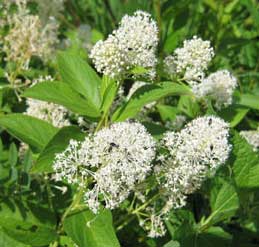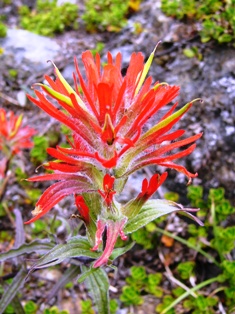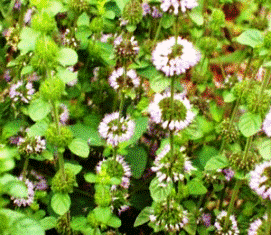Discover Florida Nature
It's time to explore the natural Florida


|
|
|
|
|
Browse through our alphabetical list of native Florida plants that
encourage butterflies into your garden, and find the perfect choices for
your Florida butterfly garden! Plants that have an asterisk beside their
name are especially high in nectar. New
Jersey Tea
(Ceanothus americanus)- New Jersey-tea is a low, upright,
deciduous
shrub that grows to only 3 feet tall.
Pubescent leaves give the
entire plant a grayish cast. Small white flowers occur in 2 inch
branch-tip clusters. A low
shrub with tiny white flowers in oval clusters rising from the leaf
axils on the new shoots, the
base is woody, while the upper portion of the plant is made up of
herbaceous, spreading branches. Cylindrical clusters (1-2" long) of
tiny, fragrant, white flowers (1/8") appear on long stalks at the stem
ends or upper leaf axils in late spring. Toothed, broad-ovate, medium to
dark green leaves (to 4" long) are gray and hairy below. Young twigs are
noticeably yellow and stand out in winter. Dried leaves were used as a
tea substitute, albeit without caffeine, in American Revolutionary War
times, hence the common name. New
Jersey Tea
(Ceanothus americanus)- New Jersey-tea is a low, upright,
deciduous
shrub that grows to only 3 feet tall.
Pubescent leaves give the
entire plant a grayish cast. Small white flowers occur in 2 inch
branch-tip clusters. A low
shrub with tiny white flowers in oval clusters rising from the leaf
axils on the new shoots, the
base is woody, while the upper portion of the plant is made up of
herbaceous, spreading branches. Cylindrical clusters (1-2" long) of
tiny, fragrant, white flowers (1/8") appear on long stalks at the stem
ends or upper leaf axils in late spring. Toothed, broad-ovate, medium to
dark green leaves (to 4" long) are gray and hairy below. Young twigs are
noticeably yellow and stand out in winter. Dried leaves were used as a
tea substitute, albeit without caffeine, in American Revolutionary War
times, hence the common name. Paint
Brush (Carphephorus spp)- Although the Indian Paintbrush is
the Wyoming state flower (adopted on January 31, 1917), these flowers
can be found throughout North America in their varieties. Blooming in
the springtime, their root system is slightly parasitic on other plants.
This plant is fairly rugged and can be found along the roadside, in
fields, and along the low coasts of Florida. Indian Paintbrush is what
botanists call a "scroph," a member of the same family as foxglove and
snapdragon. Like foxglove, Indian Paintbrush is a biennial. The first
year it grows as a small rosette inconspicuously nestled amongst the
grass and weeds. The spring of its second year it shoots skyward on a
leafy 18 inch, unbranched spike topped with an orange or scarlet
flowers. After flowering and subsequent seed set, the original plant
dies. The true flowers are small and inconspicuous with the showy
portion hairy, inch long bracts. The flowers are clustered atop of the
slender stem and, if you’re blessed with a good imagination they may
look somewhat like an artist’s paintbrush. Paint
Brush (Carphephorus spp)- Although the Indian Paintbrush is
the Wyoming state flower (adopted on January 31, 1917), these flowers
can be found throughout North America in their varieties. Blooming in
the springtime, their root system is slightly parasitic on other plants.
This plant is fairly rugged and can be found along the roadside, in
fields, and along the low coasts of Florida. Indian Paintbrush is what
botanists call a "scroph," a member of the same family as foxglove and
snapdragon. Like foxglove, Indian Paintbrush is a biennial. The first
year it grows as a small rosette inconspicuously nestled amongst the
grass and weeds. The spring of its second year it shoots skyward on a
leafy 18 inch, unbranched spike topped with an orange or scarlet
flowers. After flowering and subsequent seed set, the original plant
dies. The true flowers are small and inconspicuous with the showy
portion hairy, inch long bracts. The flowers are clustered atop of the
slender stem and, if you’re blessed with a good imagination they may
look somewhat like an artist’s paintbrush.  Pennyroyal (Piloblephis
rigida )- Florida Pennyroyal is a delightful little plant found in
flatwoods and on sandhills throughout Florida. Pennyroyal a low growing
aromatic plant, occurring in moist pineland from Alachua County
southward. It blooms November to April. It is very fragrant and is a
wonderful addition to potpourri. The Florida pennyroyal plant is
attractive to bees, butterflies and birds. It is drought-tolerant and
suitable for xeriscaping. When
planted in full sun the pennyroyal will bloom repeatedly from spring to
fall. The violet or purple blooms make a nice addition to any Floridian
garden. Pennyroyal (Piloblephis
rigida )- Florida Pennyroyal is a delightful little plant found in
flatwoods and on sandhills throughout Florida. Pennyroyal a low growing
aromatic plant, occurring in moist pineland from Alachua County
southward. It blooms November to April. It is very fragrant and is a
wonderful addition to potpourri. The Florida pennyroyal plant is
attractive to bees, butterflies and birds. It is drought-tolerant and
suitable for xeriscaping. When
planted in full sun the pennyroyal will bloom repeatedly from spring to
fall. The violet or purple blooms make a nice addition to any Floridian
garden. Redbud
(Cercus canadensis)- The Redbud tree is a relatively small tree
with spreading branches and a small short trunk. The Redbud is a poplar
ornamental tree, which can be found in many gardens and streetscapes.
The tree is one of the earliest flowering trees and is often used to add
color to gardens. The purple pink flowers of the eastern redbud appear
all over the tree in early spring. Flowers are bisexual and the tree is
self-pollinating. Flowering usually occurs sometime from March to May
and precedes leafing. The flowers are even produced on large trunks.
Redbud has a yellow fall color and is shade tolerant. The Redbud grows
throughout much of the eastern United States, including north and
central Florida, and is a favorite for both bees and butterflies. Redbud
is found on a variety of sites ranging from xeric to mesic but grows
better on moist, well-drained sites. It is normally more abundant on
south-facing slopes where sunlight is more intense and there is less
plant competition. This species does not usually grow on flooded sites
because it cannot endure inundation or survive in poorly aerated soils. Redbud
(Cercus canadensis)- The Redbud tree is a relatively small tree
with spreading branches and a small short trunk. The Redbud is a poplar
ornamental tree, which can be found in many gardens and streetscapes.
The tree is one of the earliest flowering trees and is often used to add
color to gardens. The purple pink flowers of the eastern redbud appear
all over the tree in early spring. Flowers are bisexual and the tree is
self-pollinating. Flowering usually occurs sometime from March to May
and precedes leafing. The flowers are even produced on large trunks.
Redbud has a yellow fall color and is shade tolerant. The Redbud grows
throughout much of the eastern United States, including north and
central Florida, and is a favorite for both bees and butterflies. Redbud
is found on a variety of sites ranging from xeric to mesic but grows
better on moist, well-drained sites. It is normally more abundant on
south-facing slopes where sunlight is more intense and there is less
plant competition. This species does not usually grow on flooded sites
because it cannot endure inundation or survive in poorly aerated soils.
|
|
|
Advertise | Privacy Statement | Contact | Alaska Nature | Michael Arnold Art| Dog Encyclopedia | Dog Encyclopedia| |
|